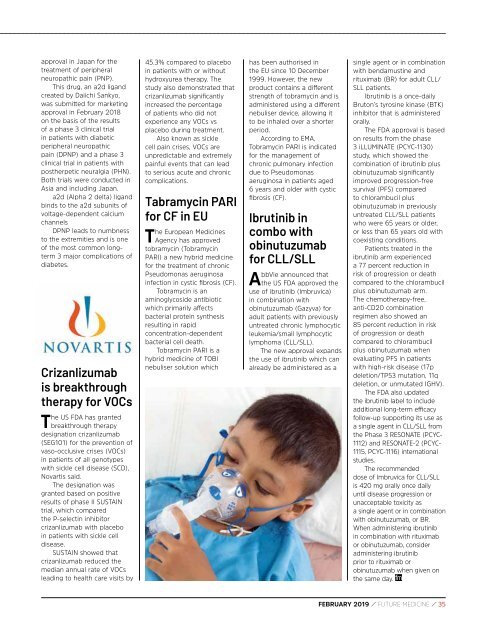You also want an ePaper? Increase the reach of your titles
YUMPU automatically turns print PDFs into web optimized ePapers that Google loves.
approval in Japan for the<br />
treatment of peripheral<br />
neuropathic pain (PNP).<br />
This drug, an a2d ligand<br />
created by Daiichi Sankyo,<br />
was submitted for marketing<br />
approval in February 2018<br />
on the basis of the results<br />
of a phase 3 clinical trial<br />
in patients with diabetic<br />
peripheral neuropathic<br />
pain (DPNP) and a phase 3<br />
clinical trial in patients with<br />
postherpetic neuralgia (PHN).<br />
Both trials were conducted in<br />
Asia and including Japan.<br />
a2d (Alpha 2 delta) ligand<br />
binds to the a2d subunits of<br />
voltage-dependent calcium<br />
channels<br />
DPNP leads to numbness<br />
to the extremities and is one<br />
of the most common longterm<br />
3 major complications of<br />
diabetes.<br />
Crizanlizumab<br />
is breakthrough<br />
therapy for VOCs<br />
The US FDA has granted<br />
breakthrough therapy<br />
designation crizanlizumab<br />
(SEG101) for the prevention of<br />
vaso-occlusive crises (VOCs)<br />
in patients of all genotypes<br />
with sickle cell disease (SCD),<br />
Novartis said.<br />
The designation was<br />
granted based on positive<br />
results of phase II SUSTAIN<br />
trial, which compared<br />
the P-selectin inhibitor<br />
crizanlizumab with placebo<br />
in patients with sickle cell<br />
disease.<br />
SUSTAIN showed that<br />
crizanlizumab reduced the<br />
median annual rate of VOCs<br />
leading to health care visits by<br />
45.3% compared to placebo<br />
in patients with or without<br />
hydroxyurea therapy. The<br />
study also demonstrated that<br />
crizanlizumab significantly<br />
increased the percentage<br />
of patients who did not<br />
experience any VOCs vs<br />
placebo during treatment.<br />
Also known as sickle<br />
cell pain crises, VOCs are<br />
unpredictable and extremely<br />
painful events that can lead<br />
to serious acute and chronic<br />
complications.<br />
Tabramycin PARI<br />
for CF in EU<br />
The European Medicines<br />
Agency has approved<br />
tobramycin (Tobramycin<br />
PARI) a new hybrid medicine<br />
for the treatment of chronic<br />
Pseudomonas aeruginosa<br />
infection in cystic fibrosis (CF).<br />
Tobramycin is an<br />
aminoglycoside antibiotic<br />
which primarily affects<br />
bacterial protein synthesis<br />
resulting in rapid<br />
concentration-dependent<br />
bacterial cell death.<br />
Tobramycin PARI is a<br />
hybrid medicine of TOBI<br />
nebuliser solution which<br />
has been authorised in<br />
the EU since 10 December<br />
1999. However, the new<br />
product contains a different<br />
strength of tobramycin and is<br />
administered using a different<br />
nebuliser device, allowing it<br />
to be inhaled over a shorter<br />
period.<br />
According to EMA,<br />
Tobramycin PARI is indicated<br />
for the management of<br />
chronic pulmonary infection<br />
due to Pseudomonas<br />
aeruginosa in patients aged<br />
6 years and older with cystic<br />
fibrosis (CF).<br />
Ibrutinib in<br />
combo with<br />
obinutuzumab<br />
for CLL/SLL<br />
AbbVie announced that<br />
the US FDA approved the<br />
use of ibrutinib (Imbruvica)<br />
in combination with<br />
obinutuzumab (Gazyva) for<br />
adult patients with previously<br />
untreated chronic lymphocytic<br />
leukemia/small lymphocytic<br />
lymphoma (CLL/SLL).<br />
The new approval expands<br />
the use of ibrutinib which can<br />
already be administered as a<br />
single agent or in combination<br />
with bendamustine and<br />
rituximab (BR) for adult CLL/<br />
SLL patients.<br />
Ibrutinib is a once-daily<br />
Bruton’s tyrosine kinase (BTK)<br />
inhibitor that is administered<br />
orally.<br />
The FDA approval is based<br />
on results from the phase<br />
3 iLLUMINATE (PCYC-1130)<br />
study, which showed the<br />
combination of ibrutinib plus<br />
obinutuzumab significantly<br />
improved progression-free<br />
survival (PFS) compared<br />
to chlorambucil plus<br />
obinutuzumab in previously<br />
untreated CLL/SLL patients<br />
who were 65 years or older,<br />
or less than 65 years old with<br />
coexisting conditions.<br />
Patients treated in the<br />
ibrutinib arm experienced<br />
a 77 percent reduction in<br />
risk of progression or death<br />
compared to the chlorambucil<br />
plus obinutuzumab arm.<br />
The chemotherapy-free,<br />
anti-CD20 combination<br />
regimen also showed an<br />
85 percent reduction in risk<br />
of progression or death<br />
compared to chlorambucil<br />
plus obinutuzumab when<br />
evaluating PFS in patients<br />
with high-risk disease (17p<br />
deletion/TP53 mutation, 11q<br />
deletion, or unmutated IGHV).<br />
The FDA also updated<br />
the ibrutinib label to include<br />
additional long-term efficacy<br />
follow-up supporting its use as<br />
a single agent in CLL/SLL from<br />
the Phase 3 RESONATE (PCYC-<br />
1112) and RESONATE-2 (PCYC-<br />
1115, PCYC-1116) international<br />
studies.<br />
The recommended<br />
dose of Imbruvica for CLL/SLL<br />
is 420 mg orally once daily<br />
until disease progression or<br />
unacceptable toxicity as<br />
a single agent or in combination<br />
with obinutuzumab, or BR.<br />
When administering ibrutinib<br />
in combination with rituximab<br />
or obinutuzumab, consider<br />
administering ibrutinib<br />
prior to rituximab or<br />
obinutuzumab when given on<br />
the same day.<br />
<strong>FEBRUARY</strong> <strong>2019</strong> / FUTURE MEDICINE / 35


















